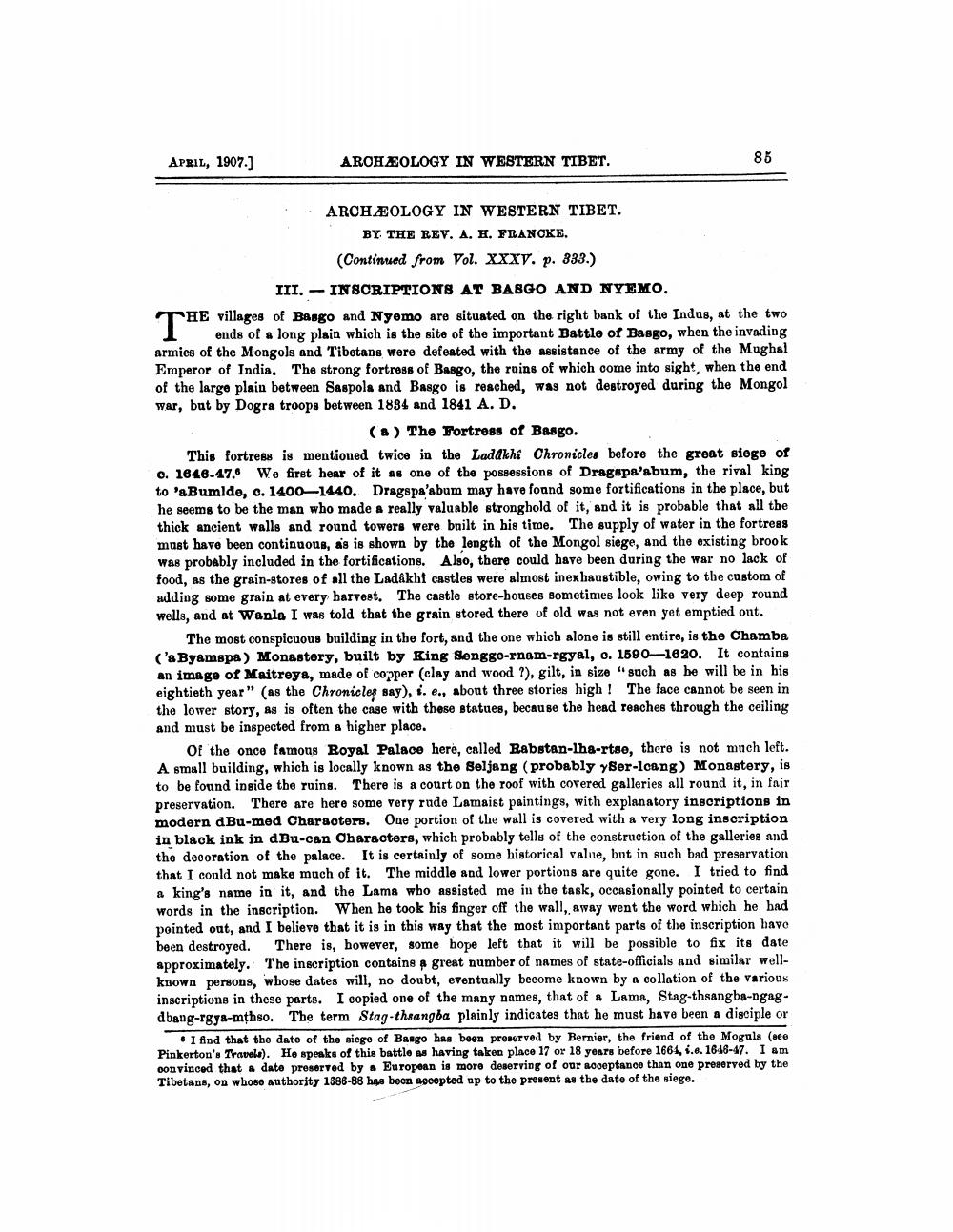________________
APRIL, 1907.]
AROHÆOLOGY IN WESTERN TIBET.
85
ARCHÆOLOGY IN WESTERN TIBET.
BY THE REV. A. H. FRANOKE,
(Continued from Vol. xxxy. p. 333.)
III. - INSCRIPTIONS AT BASGO AND NYEMO. THE villages of Bango and Nyomo are situated on the right bank of the Indus, at the two
1 ends of a long plain which is the site of the important Battle of Basgo, when the invading armies of the Mongols and Tibetans were defeated with the assistance of the army of the Mughal Emperor of India. The strong fortress of Baago, the ruins of which come into sight, when the end of the large plain between Saspola and Basgo is reached, was not destroyed during the Mongol war, but by Dogra troops between 1884 and 1841 A. D.
(8) The Fortress of Basgo. This fortress is mentioned twice in the Laddkhí Chronicles before the great siege of 0. 1646-47.6 We first hear of it as one of the possessions of Dragspa’abum, the rival king to 'aBumlde, c. 1400—1440. Dragspa'abum may have found some fortifications in the place, but he seems to be the man who made a really valuable stronghold of it, and it is probable that all the thick ancient walls and round towers were built in his time. The supply of water in the fortress must have been continuous, as is shown by the length of the Mongol siege, and the existing brook was probably included in the fortifications. Also, there could have been during the war no lack of food, as the grain-stores of all the LadAkht castles were almost inexhaustible, owing to the custom of adding some grain at every harvest. The castle store-houses sometimes look like very deep round wells, and at Wanla I was told that the grain stored there of old was not even yet emptied ont.
The most conspicuous building in the fort, and the one which alone is still entire, is the Chamba ('a Byamspa) Monastery, built by King Sengge-rnam-rgyal, c. 1590—1820. It contains an image of Maitreya, made of copper (clay and wood ?), gilt, in size "such as be will be in his eightieth year" (as the Chronicles say), i. e., about three stories high! The face cannot be seen in the lower story, as is often the case with these statues, because the head reaches through the ceiling and must be inspected from a higher place.
Of the once famous Royal Palace here, called Rabstan-1ha-rtse, there is not much left. A small building, which is locally known as the Seljang (probably yer-loang) Monastery, is to be found inside the ruins. There is a court on the roof with covered galleries all round it, in fair preservation. There are here some very rude Lamaist paintings, with explanatory inscriptions in modern dBu-med Characters. One portion of the wall is covered with a very long inscription in black ink in dBu-can Characters, which probably tells of the construction of the galleries and the decoration of the palace. It is certainly of some historical value, but in such bad preservation that I could not make much of it. The middle and lower portions are quite gone. I tried to find a king's name in it, and the Lama who assisted me in the task, occasionally pointed to certain words in the inscription. When he took his finger off the wall, away went the word which he had pointed out, and I believe that it is in this way that the most important parts of the inscription havo been destroyed. There is, however, some hope left that it will be possible to fix its date approximately. The inscription contains a great number of names of state-officials and similar wellknown persons, whose dates will, no doubt, eventually become known by a collation of the various inscriptions in these parts. I copied one of the many names, that of a Lama, Stag-thsangba-ngagdbang-rgya-mthso. The term Stag-thsangba plainly indicates that he must have been a disciple or
I find that the date of the siege of Bango has been preserved by Bernier, the friend of the Moguls (aco Pinkerton's Travels). He speaks of this battle as having taken place 17 or 18 years before 1664, 1.e. 1648-47. I am convinced that a dato preserved by a European is more deserving of our acceptance than one preserved by the Tibetans, on whose authority 1386-88 has been accepted up to the present as the date of the siege.




